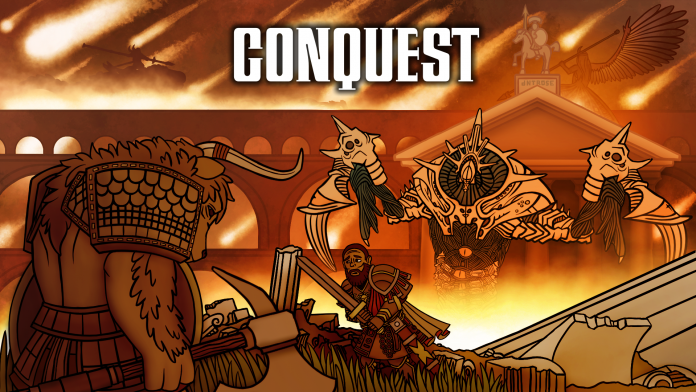Crucible of Wills 2: Fanning the Fire is a significant improvement over the Stone Face King, while still essentially being the same product. In fact, in a lot of ways I respect it a lot more than the previous entry, as a product, as a piece of writing (I note that this one has far fewer exclamation marks than the previous, which is a good sign) and as something borderline useless in the context of a real world gaming group of thirty-somethings with kids. It feels like a sharpening of everything the previous one was, and this time around I’m not confused – I’m extremely here for it.
The Models
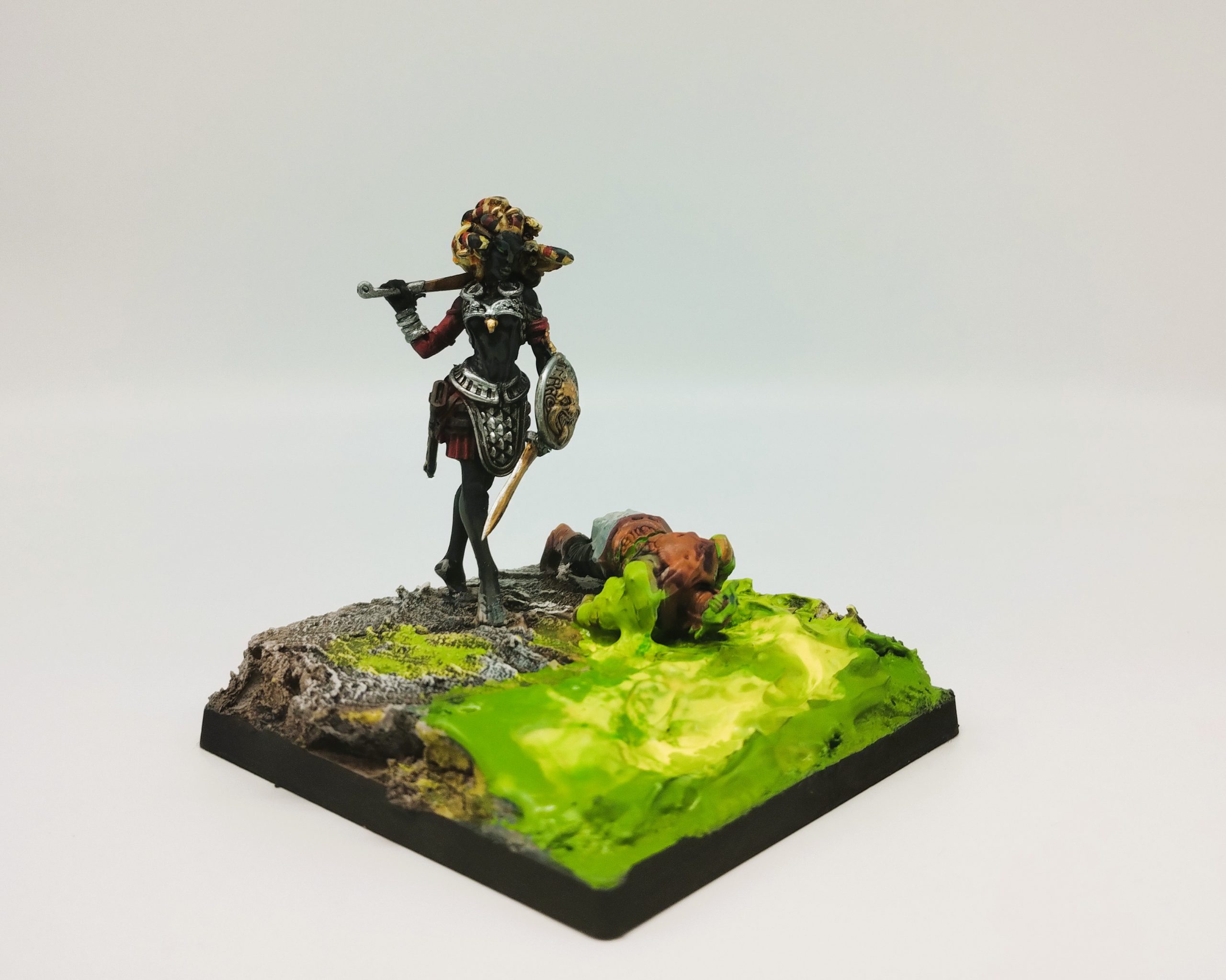
I think my reach exceeded my grasp a little with this one – it is *really* hard to paint coral snake stripes on very thin circles, no matter how small a brush I used. I also went for a deep black skin tone with subtle grey highlights that looked good under my painting lamp, and even in natural daylight, but it photographs like I’m taking a picture of a black cat in a chainmail bikini. I think I’ll need to do another pass – if nothing else, just pushing the contrast on that eye even more until the camera clearly picks it up. Maybe the green base is blowing out the contrast. Lessons learned.
As far as the model herself goes, I can’t help but get the impression she skipped leg day. She’s got an absolutely ripped six pack but all of her limbs are extremely slender. It works for the effect, she feels kind of twisted and alien. Given her stance and light armour, though, she doesn’t look at home amidst a unit of hoplites, though she’d fight right in with some Agema.
Mustercrux: Skypiercer Yindak
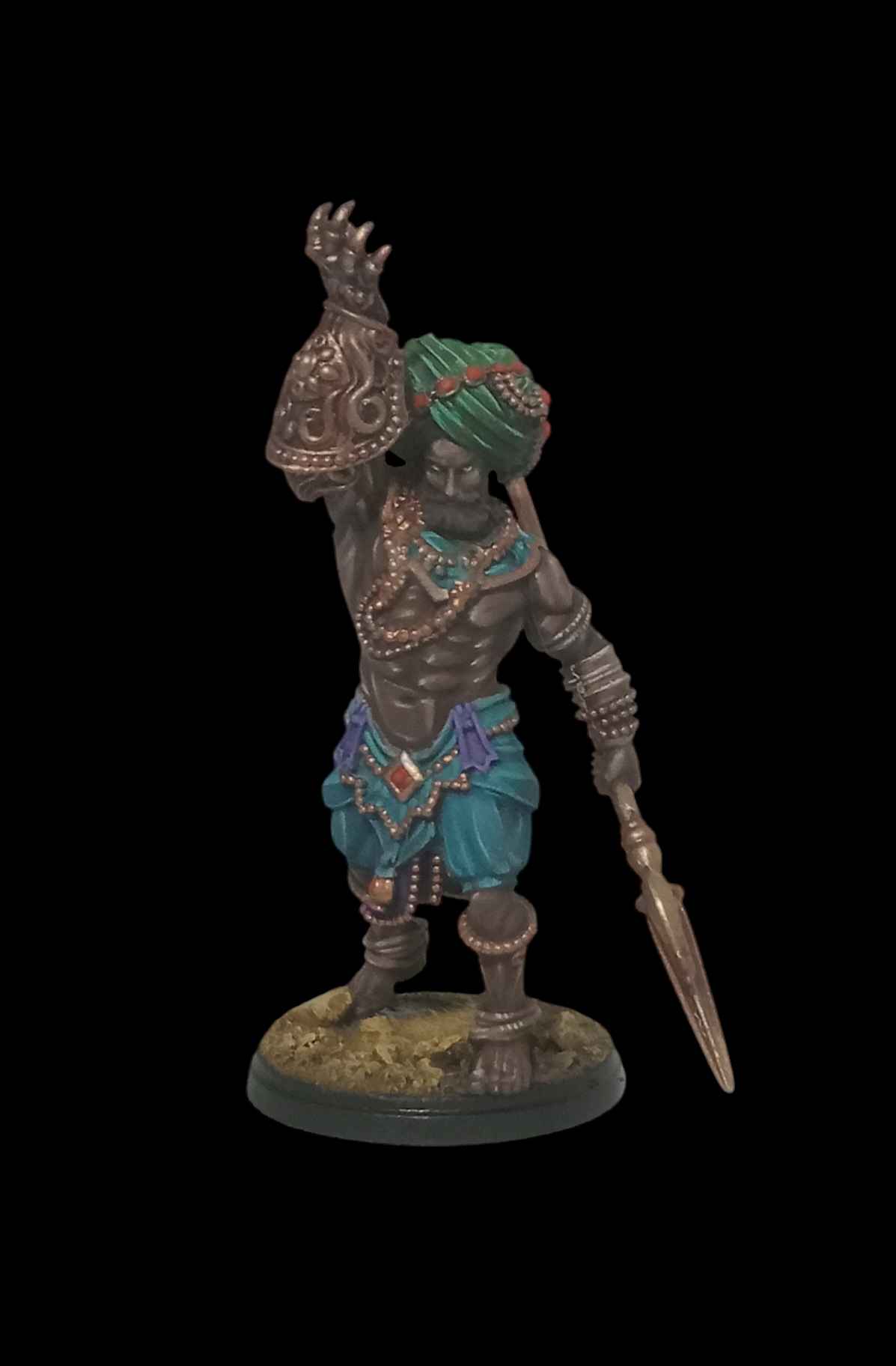
Some people like their wizards to be weedy, pale nerds who negotiate with the elements. I like my wizards to be buff, so jacked that even Gods, spirits and djinn bow to them in deference: Djacked, even. This sculpt is great, Yindak is here to make gains and gank monsters (and he’s all outta gains). The posing is quite dramatic, Yinbdak throwing an arm in the air as he summons or perhaps commands his elemental forces, the way his jewellery is sculpted helps communicate the motion of his gesture. The detail is, as ever with PB resin, gorgeous with lots of easily dry-brushed or washed sections. Despite the apparent detail and complexity of the model he’s very easy to paint. Not including assembly or zenithal undercoat, painting him took 2-3 hours and he looks pretty rad if you ask me (zenithal, contrast, highlight is the only way you’ll convince me to paint a rank-n-flank army these days). The musculature is a joy to work with, there’s enough definition in there that it’s easy to make Yindak look positively Süleymanoğlu-esque (google that one).
The Lore
Everything about the lore is a large step up from the Stone Faced King, despite keeping essentially the same format. You’ve still got only four pages of setup lore, two of which are fifty percent blank space, but the situation is much more clearly communicated and interesting. The Sorcerer Kings are foreign colonists, looking to settle a new city in a lawless borderland between the Hundred Kingdoms and the City State of Tauria. Rather than being a bizarre grudge march from an unreasoning horde of angry dwarves, this one has a backdrop of human political intrigue as both sides are increasingly pushed into conflict by opportunists looking to juice the price of iron ore.
Let’s get into it a bit more.
The Characters
Skypiercer Yindak
This one initially seemed to be leaning on a frustrating trope – who is this muscle-bound man of mystery? A djinn? An organization? But to my surprise they then resolved it into something far more interesting than that implied: Yindak is a former Raj, who murdered his treacherous twin brother in a fit of rage, and then in penance renounced his title and placed himself at the disposal of the Court of Air. Notably, he was a good and wise ruler before his fall, which both adds to the pathos of it and positions him well for his duties founding the new city of Taj’khinjaha.
Persenia the Gorgon
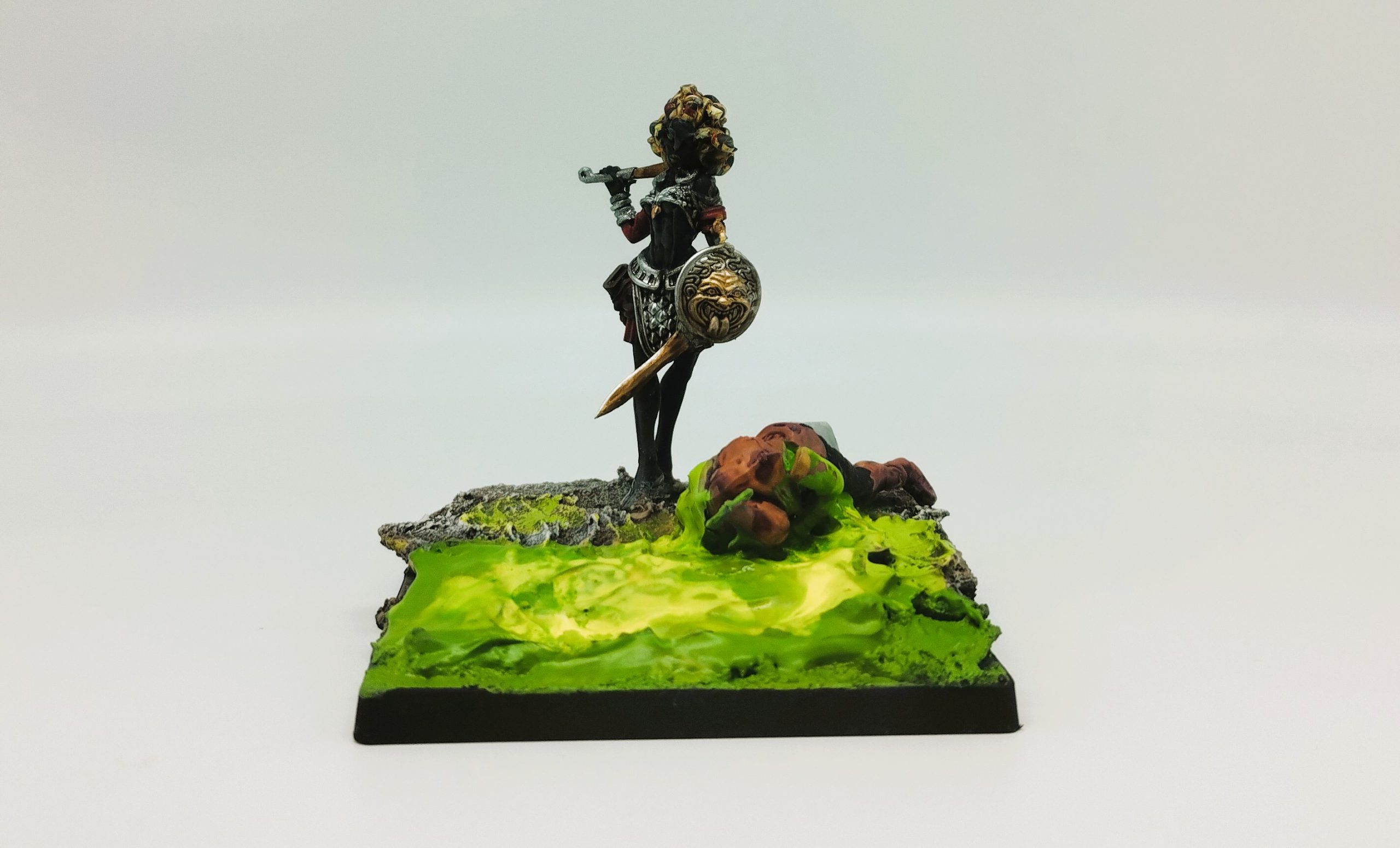
I was curious as to how this one was going to pan out – the original Gorgon was a singular creature, born of a divine curse, which is at odds with ‘medusa’ being stretched out into a fantasy race. Persenia follows in the original tradition with an interesting twist. She was a legendary hero, a Heracles-type who accomplished amazing feats, before falling to a poisoned blade in a fixed arena match. Immediately her patron, the bull god Minos, abandoned her in her moment of need, not being the type to tolerate failure of any kind. In despair, she called instead to a nameless god of vengeance whose blessing merged her with the snake-venom in her veins.
As the spice to all this, immediately after that Minos flipped back to favouring her. He abandoned her when she was a loser, and now that she was a winner he embraced her again. Persenia played nice but she was deep mad about this.
Both of these are good characters. They’ve got pathos to them. I couldn’t tell you a single thing about Schur or the Stone Faced King that’s stuck in my memory, but these two are genuinely interesting and I’d read their books.
Storied Regiments
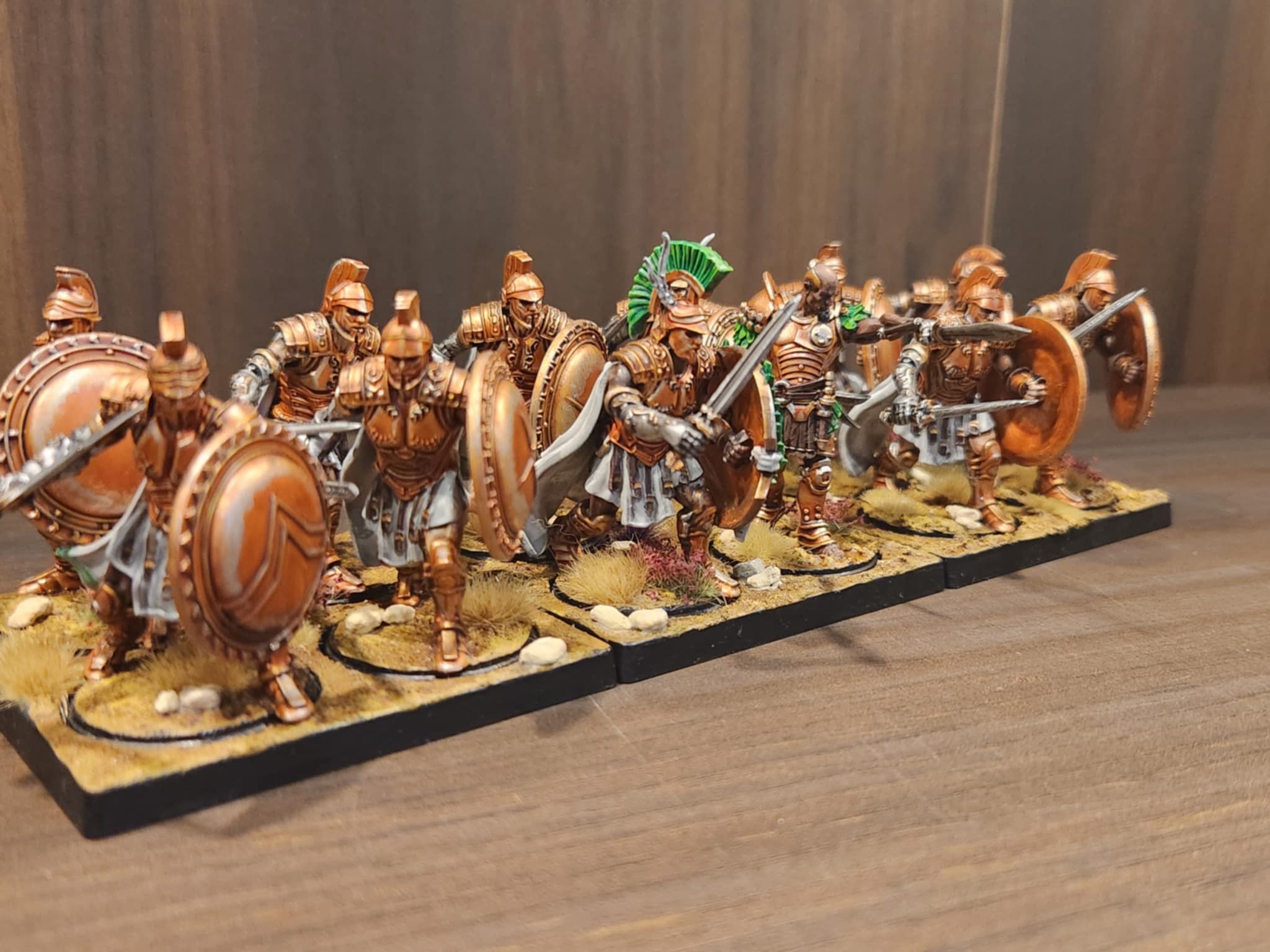
There are fewer of these than the last time around – only three apiece – but I tell you what, one of the worst and joyless jobs in the creative arts has to be writing unit descriptions like these. Almost every one of them is some combination of: These are the coolest guys, with the highest quality weapons, veterans of countless battles, unquestioningly loyal, blah blah blah. If you’ve seen one of these unit descriptions you could program an AI to spit them out forever.
That said, there is one exception, the absolutely fantastic profiles of Kal’Ethrazi the Soulflayer, a Rakshasa daemon summoned by Yindak who has one of the most flavourful stat blocks I’ve ever seen. He has rules like “I Am NOT Going Back,” “I Will NOT Return” and “Yindak You Did Not Think This Through.” Absolutely fantastic, more like this please.
The Missions
Scenario One: Under the Sanguine Moon
Last time around, I gently mocked the campaign pack for going out of its way to clarify that the first blood scenario was optional. Well they’ve outdone themselves this time – not only do they let you know the scenario is optional, they let you know that you can ignore the scenario’s narrative gimmick of summoning Ghols if you don’t have enough Ghols painted yet.
Let’s take a moment to think about that. This is a 600 point First Blood narrative scenario, in a campaign series going up to a climactic 4,000 point game. If you’re new to Conquest and are so excited to play this campaign that you’re going to do the first mission before you paint even a single box of Ghols the interval between starting this campaign and finishing its fourth mission – which makes no such allowance for the unprepared – must be understood to be around six months.
The scenario itself is an exciting one, though. The City States have sent a clandestine strike force to disrupt a magical ritual designed to summon the aforementioned Soulflayer. Absolutely classic wargaming scenario, evocative imagery, sword and sorcery beneath the moonlight and the stakes are if the Soulflayer comes into the final battle with his empowered profile or not. Moreover, every turn the Sorcerer Kings player has the choice between gaining two VP or summoning six Ghols. It’s a good scenario, creating interesting tension for both players, with the Sorcerer Kings player racing for 9 VP and the City States player trying to burn the central objective.
Scenario Two: A Plan Gone Awry

One might think that finding a local City States and Sorcerer Kings player both interested in doing a narrative campaign in a small but growing game system like Conquest is already a bit of an ask, but this scenario presents a truly sublime level of impracticality: It is for three players, and the third player must be a Hundred Kingdoms player. So, from the first mission, if you don’t have the three required factions on hand then you just can’t do this campaign at all. I love it! It’s so impractical!
Anyway, as far as three player missions go, this is honestly the best version of it I’ve ever seen in a wargame. The City States and Sorcerer Kingdoms players deploy normally, but the Hundred Kingdoms player comes in from either flank table edge. There are five objective zones, but each turn the two warring factions get the option of bribing the Hundred Kingdoms player with victory points to be loyal to them for a turn. It’s a perfect prisoner’s dilemma – if the Sorcerer Kings and City States co-operate then they can outflank and wipe out the Hundred Kingdoms player and they’ll never stand a chance, but they’re both constantly incentivized to defect and allow the Kingdoms player to build up a scoring lead.
Incidentally, I appreciate that the Hundred Kingdoms player doesn’t have a say in being bribed – you pay 2VP and all of their scoring zones go to the player paying that turn. It means that the out of game negotiations can’t get out of hand. It’s fast, sharp, and smart, a ten out of ten scenario and I want to rip it straight out of this campaign book and do it with any combination of three players I can happen to arrange.
The lore for this one is very good as well. The Merchant of Woes sells substandard iron ore, but he is being undercut by Tauria’s massive industries. So he’s been going out of his way to force the two factions into conflict, which will disrupt trade and leave him as the only game in town.
Scenario Three: Beyond Minoporta
This one is a defensive siege battle, represented by long table edge deployments and a massive positional advantage for the City States, and a big edge in scoring for if the Sorcerer Kings player can push past that into their objective zones. It also features returning troops – wipe out a unit and it’ll just come back at full strength next turn, up to two per round (though watch out because destroyed regiments give up VPs).
For all its twists, this one is going to be a slog. All of the long table edge scenarios left the mission pack in Conquest second edition, and they left for a very good reason – everyone’s crammed in tight, you can’t really maneuver, so things turn into grinding slogfests especially at 2000 points. Especially with returning regiments I foresee this one just turning into a dice push – big engaged regiments rolling dice at each other across a fairly static battle line.
Scenario Four: The Battle For Bouballa
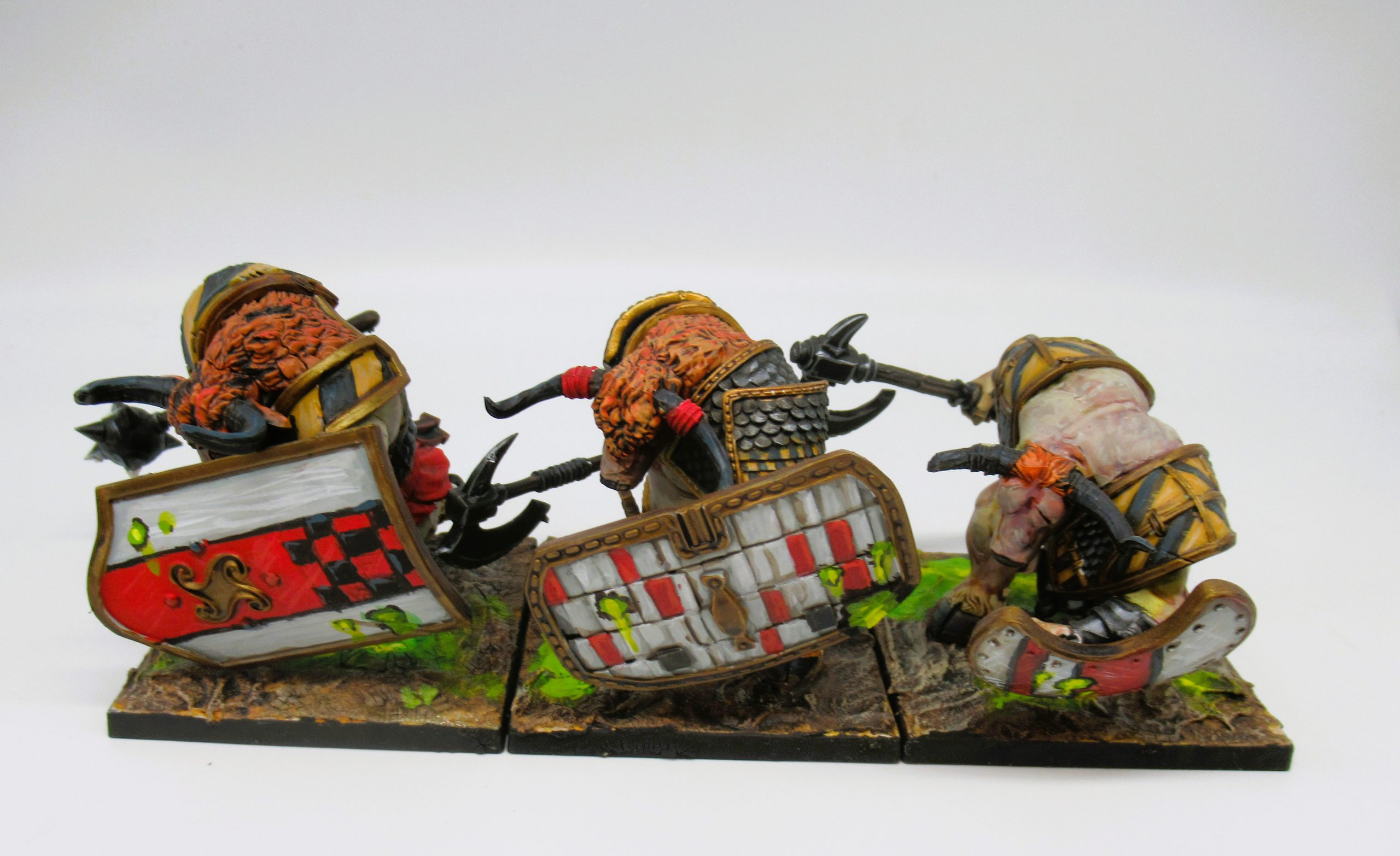
Perhaps you thought that having a City States player, a Sorcerer Kings player, and a Hundred Kingdoms player was an achievable goal and I was simply being dramatic earlier. Well, you fool, you absolute moron, you underestimated the good folks at Conquest HQ: This is a 2v2 scenario. You need two City States players and two Sorcerer Kings players in order to play this 4,000 point scenario.
What is very cute is the ability to do a Teamwork Special Combo Attack. Once per round a team can simultaneously draw their next command cards and do a wombo-combo beatdown, paying for it with an Opening! token that the opposing team can cash in for a variety of cool effects. Shouting out the name of your combined mega attack simultaneously is presumably encouraged, if not directly stated. Other than that there’s not too much complicated about this one, which is always a relief because it’s a fucking 4000 point 4 player game and there’s already a lot to think about.
Endgame
Unlike the, frankly, railroady Stone Faced King endgame where essentially the same conclusion comes out no matter who wins, the ending to Fanning the Fire is a sharp divergence. The fate of two cities, Taj’khinjaha and Bouballa, are both decided by the conclusion to this battle. If the Sorcerer Kings triumph, Bouballa is burned and is only gradually rebuilt into a shadow of its former self. Persenia loses a climactic duel and though she survives she can’t explain it away as poison or cheating, she gets her ass kicked fair and square and she’s madder about it than she’d be if she was killed outright.
The City States victory is the inverse. Persenia lets her opponent get away in the smug knowledge that the punishment from his master will be worse than anything she could do, and Tauria uses the space gained from crushing the Sorcerer Kings to build a network of defensive fortifications that strangles the growth of Taj’khinjaha in its cradle. Instead of becoming a true city, Taj’khinjaha remains a fortified colonial outpost, kept in place only due to the continued support of its offshore patrons.
Final Thoughts
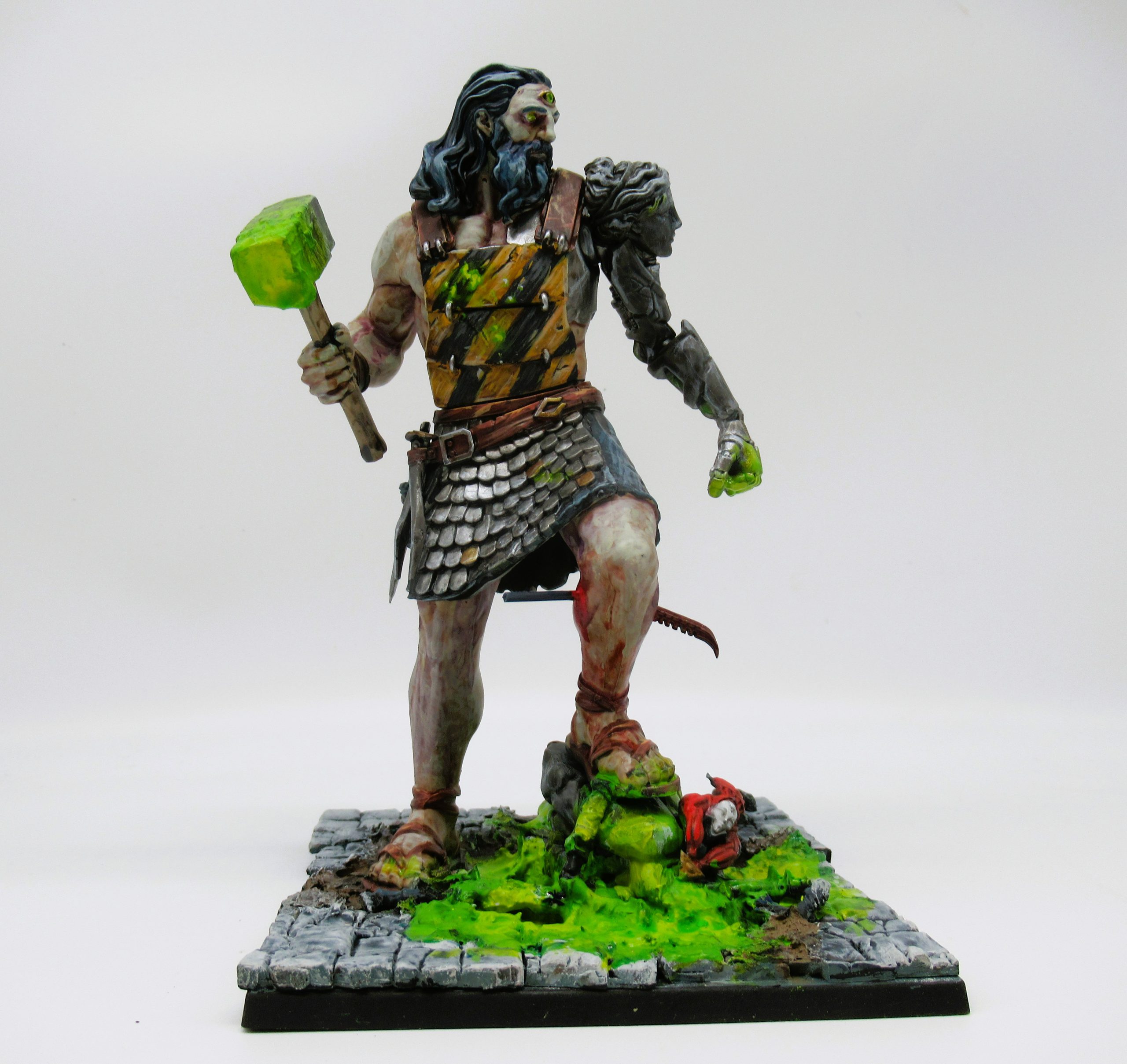
Honestly, I really enjoyed this one. It knew exactly what it wanted to be in a way the previous entry in the line didn’t, the characters were more interesting, the conflict was more involved, the stakes were higher, the ending more satisfying, the missions were better written and the logistical demands of setting up the games were even more comically impossible. While I’ll certainly never play this campaign as written – I don’t think there are two Sorcerer Kings players locally for a start – I’m definitely going to use that three player scenario at some point, and I appreciated the read as an exciting little glimpse into this world.
As always if you want to get 10% off and support Goonhammer you can make your Conquest purchase by clicking here for US/Canada or here for EU/rest of world. You’ll also need to enter code “goonhammer” at checkout.
Have any questions or feedback? Drop us a note in the comments below or email us at contact@goonhammer.com. Want articles like this linked in your inbox every Monday morning? Sign up for our newsletter. And don’t forget that you can support us on Patreon for backer rewards like early video content, Administratum access, an ad-free experience on our website and more.
